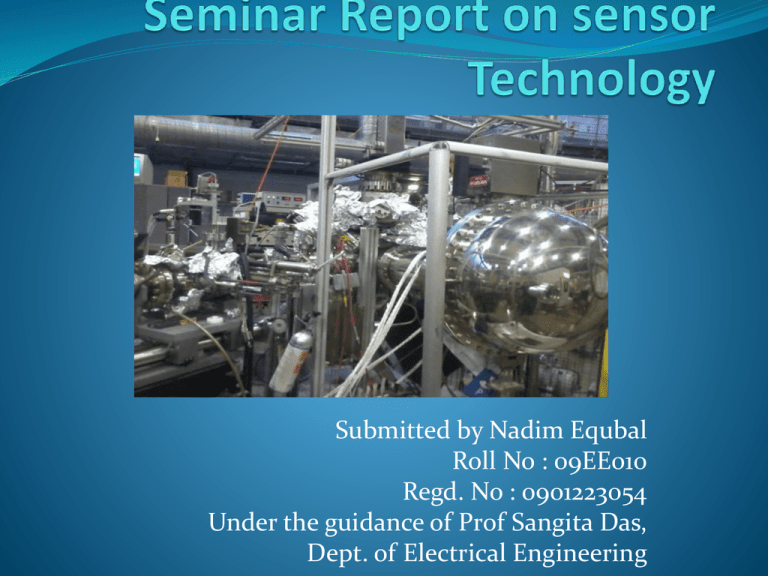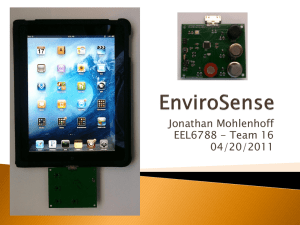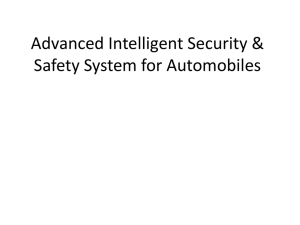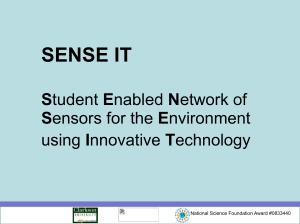Sensor Technology: Seminar Report Overview
advertisement

Submitted by Nadim Equbal Roll No : 09EE010 Regd. No : 0901223054 Under the guidance of Prof Sangita Das, Dept. of Electrical Engineering CONTENTS Abstract Introduction Properties Developments of sensor technology Sensor design Sensor structure Types of sensors Advanced sensor technology Conclusion References ABSTRACT ON SENSOR TECHNOLOGY The sensor technology plays a key role in the design of advanced electronic equipments and many other emerging fields. Without sensors most electronic applications would not exist. They perform a vital function, namely providing an interface to the real world. They determine the quality of the information that is acquired from real life and are used for production control and decision making. The global market for sensors is fast growing and the innovation rate is extremely high. The importance of sensors, however, contrasts with the limited information available on them. Today's smart sensors, wireless sensors, and micro technologies are revolutionizing sensor design and applications. This paper includes basic information about sensor, its types and its applications in advanced technology. A sensor (also called detectors) is a device that measures a measurable attribute and converts it into a signal which can be read by an observer or by an instrument. The need for new types of sensors is more critical than ever. This is due to the emergence of increasingly complex technologies, health and security concerns of increasing world . Properties Developments of sensor technology Sensor design Sensor structure Types of sensors Advanced sensor technology Conclusion References . INTRODUCTION A sensor (also called detectors) is a device that measures a measurable attribute and converts it into a signal which can be read by an observer or by an instrument. The need for new types of sensors is more critical than ever. This is due to the emergence of increasingly complex technologies, health and security concerns of increasing world population, and the emergence of terrorist activities, among other factors. Sensors are the most important component in any system and engineers in any field need to understand the fundamentals of how these components work, how to select them properly and how to integrate them into an overall system Depending on their application, the design, fabrication, testing, and use of sensors, all require various kinds of both technical and nontechnical expertise. With this in mind, “Introduction to Sensors” examines the theoretical foundations and practical applications of various types of sensors. PROPERTIES REQUIRED FOR A GOOD SENSOR Accuracy - The statistical variance about the exact reading. Calibration - Required for most measuring systems since their readings will drift over time. Environmental - Sensors typically have temperature and/or humidity limits. Range - Limits of measurement of the sensor. Repeatability - The variance in a sensor's reading when a single condition is repeatedly measured. Resolution - The smallest increment the sensor can detect. TYPES OF SENSORS: Thermal Sensors: This device collects information for the temperature measurement. The position of the mercury is observed by the viewer to measure the temperature. There are two basic types of temperature sensors: Contact Sensors: This type of sensor requires direct physical contact with the object or media that is being sensed. They supervise the temperature of solids, liquids and gases over a wide range of temperatures. Non contact Sensors: This type of sensor does not require any physical contact with the object or media that is being sensed. They supervise non-reflective solids and liquids but are not useful for gases due to natural transparency. These sensors use Plank’s Law to measure temperaturen about temperature from a source and converts into a form that is understandable by other device or person. The best illustration of a temperature sensor is mercury in glass thermometer. The mercury in the glass expands and contracts depending on the alterations in temperature. The outside temperature is the source . ADVANTAGES: • Has no effect on the medium it measures. Is precisely accurate. Responds instantly. Has an easily conditioned output. Accuracy. No Self-heat. Self-Powered. Overall Cost is low. Ease of Use. DISADVANTAGES: Non-linearity. Moisture failures. Limited applications. RESISTENCE TEMPERATURE DETECTOR A resistance tempreture detector is a tempretutre sensor based on the principle i.e metal resistance increases with tempreture. Metals used in the devivce are nickle,platinum etc. which is very sensitive. It has a time response of 0.5 to 5 sec generally. Poor thermal contact has slow response ,whereas good thermal contact has fast response. PHOTO CONSTRUCTION An RTD is simply a length of wire whose resistance is to be monitor as a function of tempreture. The wire is wound to form coil. The coil is protected from enviornment by protective shreath. LVDT LVDT(linear variable differential transformer). It is an important for displacement measurement in industrial environment. It consist of three coils of wires wound on hollow form. The inner coil is primary which is excited by some ac source. A core of permeable material can slide freely through the centre. Flux form by primary is linked by two secondary coil. LVDT DIAGRAM GRAPH WORKING When the core is centrally located the voltage in eachcoil is equal. If the core moves to one side or the other a larger ac voltage will be induced. This is due to change in flux associated with the core. Hence by change in voltage motion of core is measured. MERITS OF LVDT Linearty is good. Sensitivty is high. Low power and hysterisis loss Low cost DEMERITS OF LVDT Ac input generates noise. Sensitivity is low at high temp. Affected by electromagnetic field. BASICS OF SMART SENSOR Complete sensor systems have been realized on a single chip where traditional functions,such as signal conditioning, datacommunication, A/D conversion and the generation of reference and compensating signals are no longer performed by separate components, but are all integrated on the same IC. EVOLUTION OF SMART SENSORS Sensors have progressed through following stages First generation devices Second generation devices Third generation devices Fourth generation devices Fifth generation devices In fifth generation, data conversion is accomplished on the same sensor chip TECHNOLOGY OF SMART SENSORS A modern microprocessor-cum-micro sensor is composed of (i) the sensing element (ii) a signal processing part (iii) the microprocessor Parts (i) and (ii) are fabricated on a single chip to form a smart sensor SOME EXAMPLES OF SMART SENSORS Different smart sensors are given below: 1.HALL SENSORS 2. THREE-DIMENSIONAL EYE MOVEMENT MEASUREMENT USING SMART VISION SENSORS 3. SMART ACCELEROMETER SYSTEM 4. SMART AUDIO SENSOR FOR TELEMEDICINE SMART VISION SENSORS State-of-the-art imaging technology permits accurate threedimensional measurement of eye movement (horizontal, vertical, torsional). 3D eye measurement is done using this sensor SMART VISION SENSOR AND HOST INTERFACE IMPLEMENTATION AND FUTURE USE There are many applications of smart sensors of which some practical uses are realized as 1.Electronic compass for measurement of directions with greater accuracy. 2. Hydraulic cylinder height application for measurement of height IR SENSOR This device emits and/or detects infrared radiation to sense a particular phase in the environment. Generally, thermal radiation is emitted by all the objects in the infrared spectrum. The infrared sensor detects this type of radiation which is not visible to human eye. According to the black body radiation law, it is possible to view the environment with or without visible illumination using thermography. It is disturbed by noises in the surrounding such as radiations, ambient light etc. Fig. IR Sensor 2.2) ADVANTAGES Easy for interfacing. Readily available in market. UV Sensor: These sensors measure the intensity or power of the incident ultraviolet radiation. This form of electromagnetic radiation has wavelengths longer than x-rays but is still shorter than visible radiation. An active material known as polycrystalline diamond is being used for reliable ultraviolet sensing. UV sensors can discover the exposure of environment to ultraviolet radiation. Criteria to select a UV Sensor Wavelength ranges in nanometres (nm) that can be detected by the UV sensors. Operating temperature. Accuracy. Weight. Power range. 3.4) APPLICATIONS Measures the portion of the UV spectrum which sunburns human skin. Pharmacy. Automobiles. Robotics. Printing industry for solvent handling and dyeing processes. Chemical industry for the production, storage, and transportation of chemicals. TOUCH SENSOR A touch sensor acts as a variable resistor as per the location where it is touched. The figure is as shown below. A touch sensor is made of: Fully conductive substance such as copper. Insulated spacing material such as foam or plastic. Partially conductive material. APPLICATION Commercial – Medical, vending, Fitness and gaming. Appliances – Oven, Washing machine/dryers, dishwashers, refrigerators. Transportation – Cockpit fabrication and streamlining control among the vehicle manufacturer. Fluid level sensors. Industrial Automation – Position and liquid level sensing, human touch control in automation applications. CONCLUSION Owing to its wide range of applications sensor technology is fast gaining momentum in modern day technological world. Its applications vary from common home appliances to highly sophisticated electrical, electronic equipments. REFERENCES Wikipedia.com Wiki.answers.com www.meas-spec.com Process control instrumentation technology








